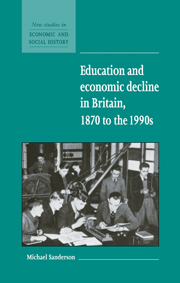Book contents
- Frontmatter
- Contents
- Acknowledgements
- Glossary and abbreviations
- Introduction
- 1 Literacy and schooling, 1870–1914
- 2 Was technical education to blame?
- 3 The counterarguments
- 4 The education of the élite, 1870–1914
- 5 Missed opportunities, 1914–1944
- 6 Post-war decline – the betrayed teenager?
- 7 Higher education and the public schools – privilege and relevance
- Conclusion
- Bibliography
- Index
- New Studies in Economic and Social History
- Studies in Economic and Social History
- Economic History Society
5 - Missed opportunities, 1914–1944
Published online by Cambridge University Press: 05 June 2012
- Frontmatter
- Contents
- Acknowledgements
- Glossary and abbreviations
- Introduction
- 1 Literacy and schooling, 1870–1914
- 2 Was technical education to blame?
- 3 The counterarguments
- 4 The education of the élite, 1870–1914
- 5 Missed opportunities, 1914–1944
- 6 Post-war decline – the betrayed teenager?
- 7 Higher education and the public schools – privilege and relevance
- Conclusion
- Bibliography
- Index
- New Studies in Economic and Social History
- Studies in Economic and Social History
- Economic History Society
Summary
The period between the two World Wars was one in which nothing went seriously wrong as regards education and likewise the economic depression that generally pervaded these years can hardly be attributed to it. But nonetheless it was a period of wasted opportunities, when experiments failed or were abandoned, access to education remained painfully constricted and education ceased to be thought of as an important contributor to the economy. The Chief Inspector of Technical Education observed gloomily in 1933, that ‘it is not generally believed that technical education can play a most important part in the struggle to increase the national well being; or if this belief is accepted, it does not generally lead to energetic action’ (Abbott, 1933 p. 214). In this the period contrasts with the enthusiastic drive of the late Victorians and Edwardians, with their almost exaggerated belief in the importance of education, and also with the post World War II years which recovered something of the impetus but made more mistakes. The peacetime years of the twenties and thirties also contrast with the two World Wars which began and ended them when education received a powerful stimulus quite lacking in less urgent times.
The First World War years were good ones for education. In schooling there was a remarkable increase in the number of children going to grammar school from 187,000 in 1914 to 337,000 by 1920.
- Type
- Chapter
- Information
- Publisher: Cambridge University PressPrint publication year: 1999

